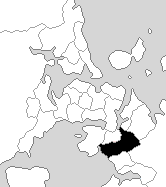
The 1978 New Zealand general election was a nationwide vote to elect the 39th New Zealand Parliament. It saw the governing National Party, led by Robert Muldoon, retain office, but the opposition Labour Party won the largest share of the vote. Reorganisation of the enrolment system caused major problems with the electoral rolls, which left a legacy of unreliable information about voting levels in this election.
Albany was a New Zealand electorate. It was located in north Auckland, and named after the suburb of Albany. It existed from 1978 to 1984, and then was reinstated in 1987 before its final abolition in 2002.
Clevedon was a New Zealand parliamentary electorate from 1987 to 1993 and then from 2002 to 2008. For the first six-year period the electorate was represented by Warren Kyd. For the second six-year period, the electorate was represented by Judith Collins.

Coromandel is a New Zealand electoral division returning one member to the House of Representatives. It is currently represented by Scott Simpson, a member of the National Party.

Hamilton West is a New Zealand parliamentary electorate. It has been held by Tama Potaka MP of the National Party since the 2022 by-election.

Helensville was a New Zealand parliamentary electorate in the Auckland region, returning one Member of Parliament to the House of Representatives. The electorate was first established for the 1978 election, was abolished in 1984, and then reinstated for the 2002 election. The seat was won and held by John Key through his term as prime minister. Chris Penk of the National Party held the seat from the 2017 general election until its abolition in 2020, when it was replaced with the new Kaipara ki Mahurangi electorate, which Penk also retained.
Piako was a New Zealand parliamentary electorate established in 1946 and disestablished in 2008. It was last held by Lindsay Tisch MP from 2002 to 2008.

Rodney was a New Zealand parliamentary electorate, returning one Member of Parliament to the House of Representatives. The last MP for Rodney was Mark Mitchell of the National Party. He held this position from 2011 until the electorate was replaced with Whangaparāoa in 2020. Mitchell stood for and won that seat.

Rotorua is a New Zealand parliamentary electorate, returning one Member of Parliament to the New Zealand House of Representatives. It was first established in 1919, and has existed continuously since 1954. The current MP for Rotorua is Todd McClay of the National Party, who won the electorate in the 2008 general election from incumbent Labour MP Steve Chadwick.

Waitakere was a parliamentary electorate, returning one Member of Parliament to the New Zealand House of Representatives. The electorate was first formed for the 1946 election and existed until 2014, with breaks from 1969 to 1978 and from 1987 to 1993. The last MP for Waitakere was Paula Bennett of the National Party, who had held this position since the 2008 election.

Papakura is an electorate for the New Zealand House of Representatives, based in the south Auckland town of Papakura. Historically, the name refers to an electorate that existed between 1978 and 1996, which with the advent of Mixed Member Proportional voting and resulting reduction in the number of constituencies was folded into a new Hunua seat. In 2002 Hunua was modified, pulled northwards and renamed Clevedon.
Matamata was a New Zealand parliamentary electorate in the Waikato, from 1978 to 1996. It was a rural and safe National electorate, held by Jack Luxton from 1978 to 1987, and then by his son John Luxton from 1987 to 1996.
Franklin was a rural New Zealand parliamentary electorate. It existed from 1861 to 1996 during four periods.
Rangiriri was a rural New Zealand parliamentary electorate in the Waikato Region from 1978 to 1984.
Horowhenua was a New Zealand parliamentary electorate, from 1978 to 1996.

Otara was a New Zealand parliamentary electorate in Auckland, from 1984 to 1996. It existed for four parliamentary terms and was represented by three members of parliament, two from Labour and one from National.

Eastern Hutt is a former New Zealand parliamentary electorate from 1978 to 1996. It was represented by two Labour MPs.
East Cape is a former New Zealand Parliamentary electorate, from 1978 to 1993.
Yaldhurst is a former New Zealand parliamentary electorate, near the city of Christchurch. The electorate was to the southwest of Christchurch, and was suburban and semi-rural.

Papatoetoe is a former New Zealand parliamentary electorate, and is part of greater Auckland.











